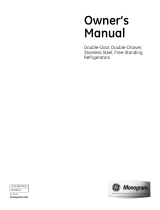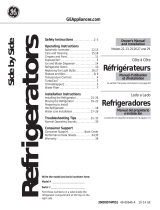GEAppliances.com
Refrigerators
Top-Freezer
197D3354P013 49-60511-1 05-09 JR
Safety Instructions . . . . . . . . . . . .2–3
Operating Instructions
Additional Features . . . . . . . . . . . . . . . . .6
Automatic Icemaker . . . . . . . . . . . . . . . .7
Controls . . . . . . . . . . . . . . . . . . . . . . . . . .4
Crispers and Pans . . . . . . . . . . . . . . . . . .6
Dispenser . . . . . . . . . . . . . . . . . . . . . . . . .7
Shelves and Bins . . . . . . . . . . . . . . . . . . .5
Water Filter . . . . . . . . . . . . . . . . . . . . . . .4
Care and Cleaning
Care and Cleaning . . . . . . . . . . . . . . .8, 9
Replacing the Light Bulbs . . . . . . . . . . .9
Installation Instructions
Preparing to Install
the Refrigerator . . . . . . . . . . . . . . . . . . .10
Reversing the Door Swing . . . . . . .14–18
Water Line Installation . . . . . . . . . .11–14
Troubleshooting Tips . . . . . . .19–21
Normal Operating Sounds . . . . . . . . . .19
Consumer Support
Consumer Support . . . . . . . . .Back Cover
Performance Data Sheet . . . . . . . . . . .27
Product Registration
for Canadian Customers . . . . . . . . .23, 24
State of California Water
Treatment Device Certificate . . . . . . . .28
Warranty for
Canadian Customers . . . . . . . . . . . . . . .25
Warranty for U.S. Customers . . . . . . . .26
Réfrigérateurs
Congélateur supérieur
Refrigeradores
Congelador superior
Model 18
Manuel d’utilisation
et d’installation
Owner’s Manual and
Installation Instructions
Manual del propietario
e instalación
La section française commence à la page 29
La sección en español empieza en la página 53
Nota al instalador – Asegúrese de
dejar estas instrucciones con el consumidor.
Nota al consumidor – Conserve
estas instrucciones para referencia futura.
Write the model and serial numbers here:
Model # __________________________
Serial # __________________________
Find these numbers on the gray label
on the left side, near the top of the
refrigerator compartment.
Refrigerators
Top-Freezer
Note to Installer – Be sure to leave
these instructions with the Consumer.
Note to Consumer – Keep these
instructions for future reference.
Note à l’installateur – Assurez-vous de
laisser ces instructions au consommateur.
Note au consommateur – Conservez
ces instructions pour référence future.
Instructions de sécurité . . . .29–30
Instructions de fonctionnement
Bacs à légumes . . . . . . . . . . . . . . . . .33
Caractéristiques additionnelles . . . .33
Clayettes et bacs . . . . . . . . . . . . . . . .32
Distributeur . . . . . . . . . . . . . . . . . . . .34
Filtre à eau . . . . . . . . . . . . . . . . . . . .31
Machine à glaçons automatique . . .34
Réglages . . . . . . . . . . . . . . . . . . . . . .31
Soins et nettoyage
Remplacement des
ampoules électriques . . . . . . . . . . . .36
Soins et nettoyage . . . . . . . . . . . .35, 36
Instructions d’installation
Installation de la
conduite d’eau . . . . . . . . . . . . . .38–41
Inversion du sens
d’ouverture des portes . . . . . . . .41–45
Préparation à l’installation
du réfrigérateur . . . . . . . . . . . . . . . .37
En cas de panne . . . . . . . . .46–49
Bruits normaux
de fonctionnement . . . . . . . . . . . . . .46
Soutien au consommateur
Feuillet de données relatives à la
performance de la cartouche . . . . . . .51
Garantie . . . . . . . . . . . . . . . . . . . . . . .50
Soutien au consommateur . . . . . . . .52
Información de seguridad . . .53–54
Instrucciones de operación
Características adicionales . . . . . . . . . . .57
Controles . . . . . . . . . . . . . . . . . . . . . . . . .55
Dispensador . . . . . . . . . . . . . . . . . . . . . . .58
Estantes y compartimientos . . . . . . .56 –57
Filtro de agua . . . . . . . . . . . . . . . . . . . . . .55
Gavetas de almacenamiento . . . . . . . . .57
Máquina de hielos automática . . . . . . .58
Cuidado y limpieza
Cómo reemplazar las bombillas . . . . . .60
Cuidado y limpieza . . . . . . . . . . . . . .59–60
Instrucciones para la instalación
Cómo invertir el vaivén de
la puerta . . . . . . . . . . . . . . . . . . . . . . .65–69
Instalación de la tubería
del agua . . . . . . . . . . . . . . . . . . . . . . .62–65
Preparación para instalar
el refrigerador . . . . . . . . . . . . . . . . . . . . .61
Consejos para la solución
de problemas . . . . . . . . . . . . . . .70–74
Sonidos normales de operación . . . . . .70
Soporte al consumidor
Hoja de datos de funcionamiento . . . .78
Garantía . . . . . . . . . . . . . . . . . . . . . . . . . .77
Soporte al consumidor . . . . . . . . . . . . . .79
Escriba aquí el modelo y el número
de serie:
Modelo # ________________________________
Serie # __________________________________
Encuentre estos números en la etiqueta gris en
el lado izquierdo, cerca de la parte superior
del compartimiento del refrigerador.
Écrivez ici le numéro de modèle et le numéro de
série :
Modèle # ______________________________
Série # ________________________________
Vous trouverez ces numéros sur l’étiquette grise
située à gauche, près du haut du compartiment
réfrigérateur.





















